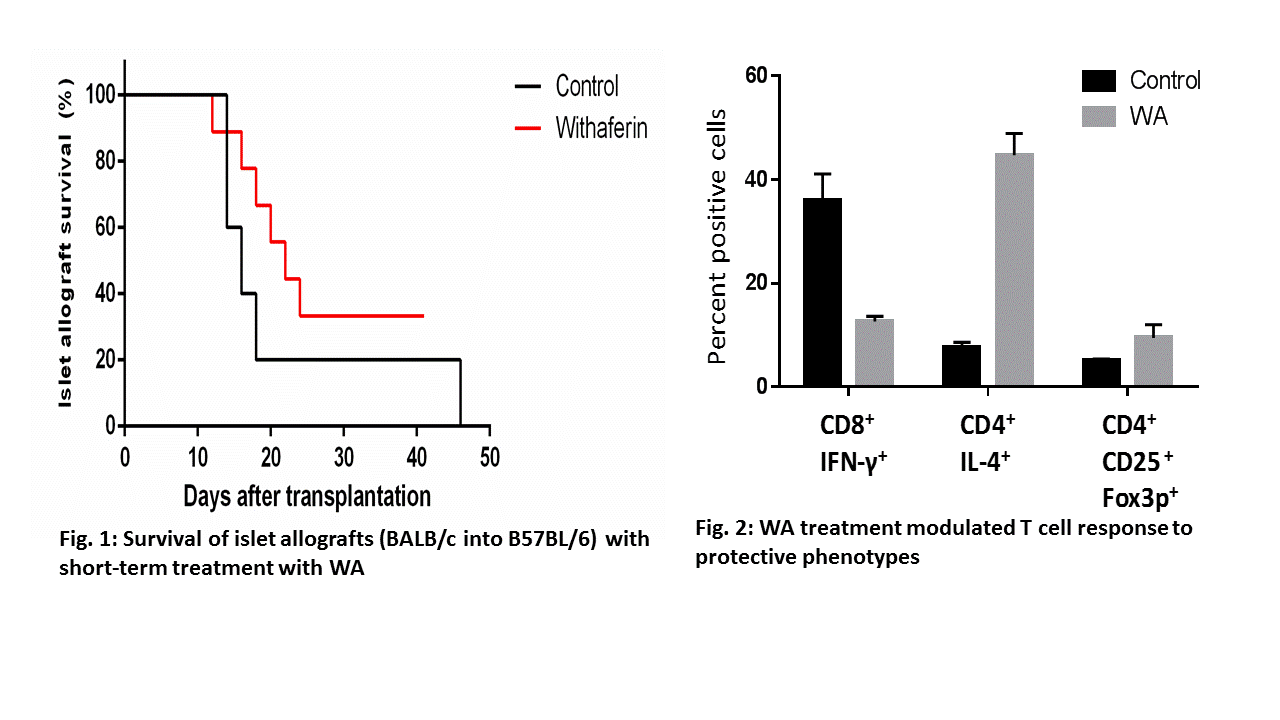Withaferin A Shifts Circulating Lymphocytes toward Protective T Cell Subsets and Prolongs Islet Allograft Survival in a Mouse Transplant Model
1Baylor Scott and White Research Institute, Dallas, TX, 2Department of Surgery, Virginia Commonwealth University, Richmond, VA, 3Institute of Biomedical Studies, Baylor University, Waco, TX, 4Baylor Simmons Transplant Institute, Dallas, TX
Meeting: 2019 American Transplant Congress
Abstract number: A117
Keywords: Allorecognition, Immune deviation, Inflammation, Islets
Session Information
Session Name: Poster Session A: Islet Cell and Cell Transplantation
Session Type: Poster Session
Date: Saturday, June 1, 2019
Session Time: 5:30pm-7:30pm
 Presentation Time: 5:30pm-7:30pm
Presentation Time: 5:30pm-7:30pm
Location: Hall C & D
*Purpose: : Immunosuppression protocols improve the efficacy of allogeneic islet transplantation. However, decline in islet graft function and toxicities imposed by current immunosuppressant drugs remain challenges to the widespread use of islet transplantation as a beta cell replacement therapy for diabetes. In this study, we evaluated a natural, plant-derived product, Withaferin A (WA) to suppress immune reactivity to islet grafts with reduced toxicity. WA is steroidal lactone having immunomodulatory properties. We previously showed that WA could prevent islet inflammation and improve islet graft function in a syngeneic mouse model. We hypothesized that suppressing the early acute inflammatory response by WA might also reduce the ensuing adaptive immune response toward allografts.
*Methods: Donor BALB/c mouse islets were transplanted into C57BL/6J recipient mice as an allogeneic graft model. Isolated donor islets were pretreated with WA 30 min prior to transplant, and recipient diabetic mice received daily WA IP injections for 7 d post transplantation. Blood glucose was evaluated in recipients for up to 60 d. Flow cytometry was performed on peripheral blood mononuclear cell (PBMCs), lymph node (LN) cells, and splenocytes from mouse and human PBMCs to determine effects of WA on T cell proliferation.
*Results: The median graft survivals of control (n=5) and WA treatment group (n=8) were 16 and 22 days, respectively and WA group showed significantly higher graft survival rate than control groups (0% vs 30%) (Figure 1). WA significantly reduced proliferation of PBMCs, LN cells, and splenocytes in BALB/c mice. WA also blocked T cell proliferation in CD3/CD28-stimulated human PBMCs in vitro. Moreover, flow cytometry analyses showed WA reduced cytotoxic CD8+IFN-γ+ (TC1) and increased CD4+CD25+Fox3p+ (Treg) and CD4+IL-4+ (Th2) T cell subsets (Figure 2).
*Conclusions: WA suppresses both innate immune and adaptive immune responses, prolonging islet allograft survival in mice. Our in vitro results indicate that WA may shift circulating T cell population profile away from cytotoxic CD8 T cells to more enriched Th2 and Treg T cell subsets, which may create a more favorable allograft environment for islet transplantation.
To cite this abstract in AMA style:
Kumano K, Kanak M, Darden C, Vasu S, Liu Y, Lawrence MC, Naziruddin B. Withaferin A Shifts Circulating Lymphocytes toward Protective T Cell Subsets and Prolongs Islet Allograft Survival in a Mouse Transplant Model [abstract]. Am J Transplant. 2019; 19 (suppl 3). https://atcmeetingabstracts.com/abstract/withaferin-a-shifts-circulating-lymphocytes-toward-protective-t-cell-subsets-and-prolongs-islet-allograft-survival-in-a-mouse-transplant-model/. Accessed December 28, 2025.« Back to 2019 American Transplant Congress

